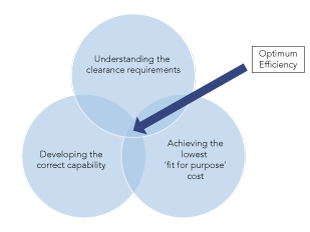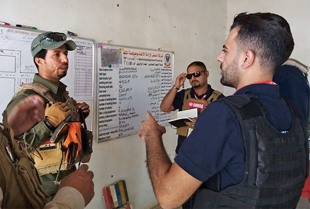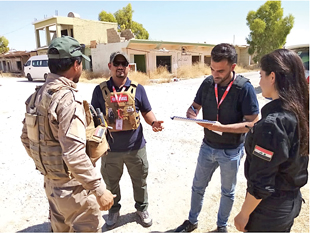National Capacity Building for Humanitarian Mine Action Activities in Iraq
By Mark Wilkinson, PhD [ United Nations Mine Action Service, Iraq ]
CISR JournalThis article is brought to you by the Center for International Stabilization and Recovery (CISR) from issue 25.3 of The Journal of Conventional Weapons Destruction available on the JMU Scholarly Commons and Issuu.com.
In the last two years, the United Nations Mine Action Service (UNMAS) Iraq has conducted detailed research into its management and delivery of improvised explosive device (IED) clearance activities. Some of this research has already been published, providing a more detailed insight into how operational efficiency and effectiveness can be developed from models and tools derived from on-the-ground evidence. Much of this research has been shown to have real-world application, and the purpose of this research has actually been quite simple: show that when methodologically sound observation and analysis are contextualized within an operational mine action environment, there can be clear and demonstrable benefits in clearance output as well as value for money. For UNMAS Iraq, the results of this work have manifested in more sophisticated understandings of the operational environment, a logical basis for the structuring of clearance teams, and an evolution of procurement processes. In addition, this research has also driven a more innovative and open-minded approach to the delivery of clearance—see, for example, the recently published analysis of the use of mechanical equipment in IED clearance from UNMAS Iraq.¹ However, this research not only has value in terms of innovation and thought leadership, it also helps demonstrate a far more striking dynamic—that conceptual clarity can also directly drive evolution in the delivery of humanitarian mine action (HMA) activities.
An initial analysis of the whole life (procurement to demobilization) phases of clearance capacities delivered by UNMAS Iraq showed that appropriate, effective, and efficient clearance capacities appeared to depend upon the balance of three key tenets: an understanding of the exact clearance requirement, development of the correct clearance capability, and achievement of the lowest fit-for-purpose cost. Considered together, particularly within the context of the procurement of new clearance capacities, it was clear that a more comprehensive approach—focusing on the actual effects (for example organizational leadership and management development) that a capacity was required to deliver—could offer significant benefits.
Understanding the Clearance Requirement
Understanding the clearance environment is obviously fundamental to the development of any mine action capacity. In Iraq, a detailed analysis of multiple clearance locations worked on over several years of intense activity led to the development of definitions for simple and complex environments.

Venn diagram depicting optimum efficiency within humanitarian mine action.All graphics courtesy of UNMAS/Iraq.
For the definition of a simple environment, three variables appear to exist: technical, threat, and concentration of contamination. With regards to technical complexity, evidence showed that within simple environments, most IEDs were of a consistent and relatively simple design (for example, with single, high-metal-content pressure plates; single battery; single detonator; short length of detonating cord; and single main charge). Threat assessments conducted in simple environments routinely provided relatively low-risk findings in terms of difficulties for clearance teams (in locating devices) as well as for IED operators (in formulation and conduct of render safe procedures). Here, the clearance environment might be considered two dimensional with surface and sub-surface planes.2 Finally, in terms of the concentration (or extent) of contamination, simple environments reflected high numbers of normally identical IEDs, often in straight lines (or belts). Considered together, these three variables were considered to be representative of simple environments.3
Further operational research showed that complex environments were defined by six variables: (1) a diverse range of complex IEDs, (2) the quantity of IED threats, and other explosive hazard (EH) threats present; (3) a three-dimensional environment (surface, sub-surface, and vertical planes); (4) challenges in accessibility to clearance sites for threat assessment; (5) reliance on semi-remote means for neutralization; (6) and the often extreme consequences of accidental initiation. These variables describe an environment far more challenging for the delivery of safe and effective IED search, location, and neutralization than for clearance activities in simple environments. Regardless, the defining features of both complex and simple environments into which clearance capacities will be committed are intimately linked to the processes used to procure the correct clearance capacity, as well as the cost of doing so.4
Developing the Correct Capability
From this new understanding of the defining characteristics of the clearance environment, UNMAS went on to use an evidence-based approach to develop a composite measurement of both environmental and technical factors that could be used to drive the development of optimized clearance capacities. The resulting lethality index provided a way to consider each variable that contributed to overall task lethality as becoming a tool used to determine time-on-task and overall efficiency. This gave the conceptual basis for, as well as a signpost toward, initiatives to continue to refine and develop meaningful and metric-based tools that might optimize clearance teams for specific environments. The development of clearance projects with modular teams (as currently seen in residential area clearance activities in Sinjar) represents one example of the utility of this type of flexible approach.
The value of the lethality index lies in its ability to drive the development of clearance team capacity in three key ways. First, it establishes a clear process for identifying appropriately trained and equipped teams for clearance tasks directly relevant to the IED environment and its technical considerations. Second, it acts as a tool to identify cost savings early in the procurement cycle for clearance teams tailored for actual operational requirements. Third, it supports the nationalization and development of local clearance teams through its rationalization of the process of training design, training delivery, on-the-job training, and continuing professional development.5
Achieving the Lowest Fit-for-Purpose Cost

An NNGO team leader delivers a briefing at the start of a working day.
So, assuming a sound understanding of the IED clearance requirements and the capability required to deliver that activity, how can the lowest fit-for-purpose cost be ensured? To answer this, UNMAS turned its attention to conducting an evidence-based analysis and measurement of cost and performance data for each clearance contract delivered under its authority. Of vital importance, this work also formed the basis of additional research relating to the fundamental donor question, “How much should clearance cost?” This work effectively showed how a detailed understanding of the threat environment could drive the procurement of the most effective clearance capacity, which in turn results in the overall reduction of cost.
As a result, UNMAS Iraq was able to design and introduce a lower-cost, higher-return business model that offered a logical and coherent approach to procurement and operational planning, cost reduction, and performance gains, all aligned with and compliant to International Mine Action Standards for Quality Management. Known as the new model, the subsequent procurement of IED clearance activities resulted in a reduction of the contracted cost of like-for-like clearance contracts by a factor of five over a two-year period.6 With a sound, evidence-based justification of the requirement for specific clearance capacity directly linked to the operating environment, the new model effectively challenged the high costs and profit margins of commercial clearance contractors in Iraq, while also directly questioning pre-conceived norms relating to the make-up of clearance teams. Specialist commercial clearance companies who were unable to adapt their operating models were quickly replaced by international non-governmental organizations (INGOs) who were able to operate with much lower overheads and overall project delivery costs. In simple terms, a thorough understanding of the precise clearance requirement (and environment), the clearance capability actually required, and what the lowest fit-for-purpose cost could be, defined optimum efficiency.
Towards Sustainable National Capacity
As new model contracts became operational in Iraq, their role in initiating a more cost-effective approach to IED clearance became clear—one that could not only further drive down costs per-unit-of-clearance in order to match the quickly reducing funds available from donors but also mark a significant milestone in the transition of clearance capacity from international to national actors. Not only was this an exciting opportunity for UNMAS, it offered the possibility of developing a model for IED clearance that could address one of the key paradoxes of HMA: how to break the cycle of the requirement for full- and long-term funding by the international community. The prize for this work could be significant—not only proof of the effectiveness of the processes described so far and the possibility of broader application across other humanitarian activities—but also the possibility of a clear end state for donors. The lasting legacy could be a sustainable national clearance capacity.
The Next Step in the Evolution: The Partnership Model
The development of the Partnership Model marked a watershed for UNMAS Iraq. Through a not-for-profit modality (using a grant), a methodology was built on the success and opportunities for further development from the new model. Central to the logic of the partnership model was that it fostered the development of long-term partnerships between experienced and credible INGOs with national (Iraqi-registered) NGOs (NNGOs).
The logic here was simple: take an experienced HMA actor and fund it for a two-year period to develop an inexperienced and perhaps unaccredited NNGO to the point that it can effectively and independently engage in EH clearance activities in its own right as an exclusively Iraqi actor. Implicit in this aim was that a national EH clearance NGO is not, and most likely cannot, focus solely on clearance activities from the outset. This model therefore recognized that the capacity to conduct physical EH clearance is inseparably linked to the capabilities required to generate, train, direct, and manage that capacity. As a result, the model is built around an explicit acknowledgement that capacity enhancement comes before clearance activities.
What Does an Effective Mine Action Actor Look Like?
In order to successfully manage this project, care was taken to ensure that the required development activities detailing what the INGO would actually do for and with the NNGO was not defined in absolute and specific terms. The logic of this was that, by definition, an INGO specializing in HMA had already proven its ability to develop capacity in multiple countries and environments. The track record for delivery of multiple projects along with a solid reputation meant that the partnership model effectively trusted the INGO to do what it knew it could do, should do, and needed to do in order to build and develop its NNGO partner. Regardless, some clarity was still required with regards to what capacity development actually meant. As a result, a fundamental part of the work to develop this model was both an analysis of, and provision of direction on, what an effective mine action actor could look like.
The concept of delivery of the partnership model therefore identifies specific capacities (i.e., the things to be produced) linked to specific capabilities (i.e., the things the NNGO can then do as a result) in order to achieve a desired effect (i.e., the overarching objective of the project; an NNGO that can effectively and independently engage in EH clearance activities, in its own right, as an exclusively Iraqi actor). The capabilities are effectively the individual strands of the single rope that represents the NNGO’s ability to function independently and effectively.
| Management |
The NNGO shall be capable of conducting the planning, organization, direction, and control required in order to harness its capacities to deliver its full range of capabilities effectively and efficiently, in accordance with national and international mine action standards |
|
Programmatic |
The NNGO shall be capable of independently identifying, bidding for, and winning funding sources to sustain its activities, with a positive media presence, into the future |
|
Operational |
The NNGO shall be capable of safely, effectively, and efficiently delivering EH clearance activities in urban and rural environments (using non-explosive means) in accordance with national and international mine action standards |
|
Support |
The NNGO shall be capable of providing those support functions required to enable and facilitate the effective running of the NNGO |
|
Quality Management |
The NNGO shall be capable of using a Quality Management System to ensure internal and external requirements are met and that continuous improvement takes place for both operational (i.e. clearance—in accordance with national and international mine action standards) and organizational activities |
|
Leadership |
The NNGO shall have leaders that motivate individuals at all levels to successfully carry out their duties, and aim to retain and promote them, regardless of sex, age, ethnicity, or religion |
|
Risk |
The NNGO shall be capable of systematically identifying, evaluating, and prioritizing risks (related to both operational and organizational activities) and applying resources in a coordinated and economical manner to minimize, monitor, and control the probability or impact of negative events whilst maximising related opportunities |
|
Resource Mobilization |
The NNGO shall be capable of securing its own resources in order to sustain and develop its ongoing activities |
The Development Process: Capacities, Capabilities, and Effects
The capacities, capabilities, and effects within the partnership model specifically relate to eight functional areas that were identified following a detailed analysis of multiple mine action organizations and projects. While not exhaustive, they do represent the key elements that might define a credible mine action organization. At the same time, and relevant to consideration of project risk, the embedding and presence of these capacities within the target NNGO offer at least some confidence in the ability of that organization to function in its own right.
Methods for Monitoring and Evaluating Delivery
The concept of delivery for the partnership grant was set against an indicative two-year timeline that reflected both the anticipated funds available for the project as well as an estimation of the likely time it would take to develop an NNGO capacity that could stand alone with a reasonable chance of survival. A total of eight milestones were defined over the two-year duration of this project, falling at the 3, 6, 9, 12, 15, 18, 21, and 24 month points. These serve as a mechanism to monitor progress as well as manage associated risk within the project, allowing for timely intervention if needed. While the timeline was indicative of expected progress, it was not developed in a manner that was intended to constrain activities, nor be naïve to the possibility of delay and slippage, for example due to delays in obtaining accreditation from the national mine action authority.
In addition to delivery against time, the partnership model also utilizes a monitoring and evaluation (M&E) system that is based on the work plans produced by each INGO, reviewed at specific phases of the project. This allows the INGO to report monthly progress against each capacity development activity, aligned with and measured against each defined end state. While a large amount of evidence is produced related to each development activity, this is currently seen as an appropriate way to monitor progress of the projects.

The end point? A national UNMAS Ops/QA officer speaks with a national clearance team leader and other staff during a clearance task.
The Partnership: 2 Plus 1
While the model utilizes a partnership between the INGO and NNGO, it is also a partnership with UNMAS Iraq. Honest, open, and frank discussion throughout the project is seen as critical to ensuring its overall success, and this has required a fundamental shift in the UNMAS understanding of quality assurance activities. The transition from the perception of some implementing partners of UNMAS as a policing organization to an equal partner will continue to require work, but early results are encouraging within the context of the extremely strong and positive relationships that have been developed so far.
The Future
What lies ahead? The partnership model has been developed not only as a logical response to the changing landscape and dynamics of clearance in Iraq, but also as an efficient way to exploit the by-product of several years of expensive commercial contracts, which has produced large numbers of trained and experienced national staff. If successful by the end of the three partnership model grants currently funded in Iraq up to October 2022, there will be three Iraqi NNGOs trained, structured, and ready to continue clearance activities under their own funding and in a transparent and well managed manner. It is also likely that the cost to continue to deliver clearance activities using these NNGOs will be significantly cheaper than it is currently. Not only does this offer better value for donors, it also represents a clear pathway for UNMAS to hand over and exit leaving a legacy of professional, high-quality, effective, and efficient national mine action actors. ◊
 Mark Wilkinson, PhD
Mark Wilkinson, PhD
Senior Operations Manager
United Nations Mine Action Service, Iraq
Mark Wilkinson, PhD, is the Senior Operations Manager for UNMAS in Iraq. He has twenty years of professional experience in military and HMA. As a former British Army Ammunition Technical Officer, he worked as a High Threat IEDD Operator in several operational environments before transitioning to HMA. Wilkinson has an active research agenda focused around IED clearance in HMA environments.

